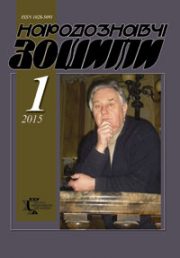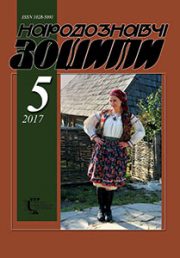The Ethnology Notebooks. 2021. № 5 (161), 1050—1062
UDK 398.3:664.6( 477.87-2=161.2)
DOI https://doi.org/10.15407/nz2021.05.1050
ZIUBROVSKYI Andrii
- ORCID ID: https://orcid.org/0000-0002-2221-3731
- Candidate of Sciences in History, Senior Researcher,
- the Institute of Ethnology of the National
- Academy of Sciences of Ukraine,
- the Department of Historical Ethnology,
- 15, Svobody Avenue, 79000, Lviv, Ukraine,
- Contacts: e-mail: anzjubr@gmail.com
Abstract. The extraction of bread from the oven was the final stage of the baking cycle of the Ukrainians of ethnographic Volyn. This stage, according to rudimentary worldviews about the analogy of baking bread with the life of man, was associated with its symbolic «birth». The object of research is the stage of taking bread out of the stove in baking process of Ukrainians of ethnographic Volyn, and the subject is folk customs, rites, traditions, technological prescriptions and signs that accompanied the taking of pastry from the stove and completed the baking cycle, their typology and probable semantics. The methodological basis of this exploration is general scientific methods of historical-comparative, typological, as well as methods of deduction and induction analysis. Special emphasis is placed on the use of specific ethnological methods: field ethnographic research (interviews, photo-fixation). A significant amount of author’s field ethnographic materials is introduced into scientific circulation. Extremely insufficient study of the issue is the main relevance of the theme. Therefore, the purpose of this exploration is to fill gaps in this field of ethnography, by identifying typological, semantic-semiotic and, partly, genetic-evolutionary sources of the origin of the custom of the stage of extraction of bread. The author comes to the general conclusion that the syncretic custom of the studied stage is based on archaic layers of pre-Christian commemorative beliefs of Ukrainians associated with honoring the souls of deceased relatives, ideas about the afterlife, and the rudiments of elemental cults, especially honoring of fire. At the extraction stage, the newly created product — bread was symbolically inscribed in the space of the developed living expanse. Also, from a realistic point of view, through various behavioral prohibitions, the very probability of acquiring bread with uncharacteristic taste, consumer or aesthetic qualities (for example, a ban on putting aside, etc.) were impossible. This stage of baking also had a special remote programming purpose, namely to provide a link to the next baking cycle and predict its successful completion. As for the rational component of the bread extraction stage, it is based on deep empirical knowledge of Volynians, and Ukrainians in general, regarding organoleptics and biochemistry of bread, thermal characteristics of the oven.
Keywords: bread, oven, flour, firewood, fire, water, steam, stove bottom, hell, otherworld.
Received 7.08.2021
REFERENCES
- Artiukh, L. (1977). Ukrainian folk cooking [in Ukrainian].
- Gontar, T. (1979). Folk food of the Ukrainians of the Carpathians [in Ukrainian].
- Tsypyshev, S. (2009). Traditional bread products of Rivne Polissya in the early twentieth century (According to field materials from Dubrovytsia and Sarny districts of Rivne region). Polissieznavstvo in folklore-ethnographic and literary-artistic researches: Scientific edition (Pp. 99—107) [in Ukrainian].
- Konopka, V., & Ziubrovskyi, A. (2018). «From grain to bread»: semantic-structural analysis of Ukrainians` agricultural way of life (on the data of the South-Western historic-ethnographic macro region). Lviv [in Ukrainian].
- Ziubrovskyi, A. (2018). Folk traditions of baking bread of Ukrainians in the late XIX — early XXI century (According to the data South-Western historic-ethnographic macro region of Ukraine). Kyiv [in Ukrainian].
- Archive of the Institute of Ethnology of the National Academy of Sciences of Ukraine (hereinafter: Archive of IE NASU). F. 1. Op. 2. Act. 683: Field ethnographic materials on the topic «Bread in the traditional culture of Ukrainians» were recorded by Andrii Viktorovych Ziubrovskyi on June 2—5, 2010 in Shumsk district of Ternopil region [in Ukrainian].
- Archive of IE NASU. F. 1. Op. 2. Act. 685: Field ethnographic materials on the topic «Bread in the traditional culture of Ukrainians» were recorded by Andrii Viktorovych Ziubrovskyi on July 7—19, 2010 in the Horokhiv district of the Volyn region [in Ukrainian].
- Archive of IE NASU. F. 1. Op. 2. Act. 688: Field ethnographic materials on the topic «Bread in the traditional culture of Ukrainians» were recorded by Andrii Viktorovych Ziubrovskyi on July 7—13, 2011 in Brody and Radekhiv districts of Lviv region [in Ukrainian].
- Archive of IE NASU. F. 1. Op. 2. Act. 686: Field ethnographic materials on the topic «Bread in the traditional culture of Ukrainians» were recorded by Andrii Viktorovych Ziubrovskyi on August 27—29, 2010 in Zdolbuniv district of Rivne region [in Ukrainian].
- Archive of IE NASU. F. 1. Op. 2. Act. 689: Field ethnographic materials on the topic «Bread in the traditional culture of Ukrainians», recorded by Andrii Viktorovych Ziubrovskyi on July 4—8, 2012 in Kamianka-Buzka district of Lviv region [in Ukrainian].
- Archive of IE NASU. F. 1. Op. 2. Act. 791: Field ethnographic materials on the topic «Bread in the traditional culture of Ukrainians», recorded by Andrii Viktorovych Ziubrovskyi on July 3—13, 2013 in Chernyakhiv, Chervonoarmiisk and Novograd-Volynsk districts of Zhytomyr region [in Ukrainian].
- Kibort, J. (1897). Poor nobility at Volyn. Wisla, 2 (Vol. 11, pp. 270—286) [in Polish].
- Myloradovych, V., & Ponomarov, A. (Eds.) (1991). Life-being of the Lubny peasant. Ukraintsi: narodni viruvannia, poviria, demonolohia (Pp. 170—341) [in Ukrainian].
- Shchelokovskaia, V. (1899). Food and drink of peasants-maloros`, with some customs, beliefs and omens related here. Etnohraphicheskoie obozreniie, 1—2, 266—322 [in Russian].
- Zahlada, N. (1931). Food in the village Starosillia in Chernihiv region. Materiialy do ethnolohii. Materials for the monograph village Starosillia (Vol. 3, pp. 83—196) [in Ukrainian].
- Rehor, Fr. (1896). Consecration of Rus` lodging in Galicia (from the vicinity of Zhydachiv). Lud (Vol. 2, pp. 141—146) [in Polish].
- Siletskyi, R. (2011). Traditional building rituals of Ukrainians [in Ukrainian].
- Ziubrovskyi, A. (2021). Traditional methods, ways and criteria for checking the readiness of the stove for bread settling in Volyn in the late XIX— early XXI century. The Ethnology Notebooks, 1, 73—83) [in Ukrainian].
- Archive of IE NASU. F. 1. Op. 2. Act. 598-a. Field ethnographic materials on the topic «Bread in the traditional culture of Ukrainians», recorded by Andrii Viktorovych Ziubrovskyi on July 4—10, 2009 in Hoscha and Ostroh districts of Rivne region [in Ukrainian].
- Rokossowska, Z. (1899). Bread. Its significance in the world conceptions, the healing and the daily life, gathered in the village Yurkovszczyzna Zwiahel district. Wisla (Vol.13, pp. 153—158) [in Polish].
- Borisenko, V. (1997). Rites of human life cycle. Kholmshchyna i Pidliashshia: Istoryko-etnohrafichne doslidzhennia (Pp. 282—309) [in Ukrainian].
- Udziela, S. (1890). Polish people in the county of Ropczycia in Galicia (Part. I). Zbior wiadomosci do antropologii krajowej (Vol. 14, pp. 1—136) [in Polish].
- Cisek, M. (1889). Ethnographic materials from the town of Zoluni in the Peremyshl district. Zbior wiadomosci do antropologii krajowej (Vol. 13, pp. 54—83) [in Polish].
- Zaleski, A. (1897). Folk conceptions of nature. Wisla, 4 (Vol. 11, p. 802) [in Polish].
- Plotnikova, A., & Tolstoi, N. (Ed.). (2009). Full — Empty. Slavic antiquities: Ethnolinguistic dictionary: in 5 vol. (Vol. 4, pp. 145—147). Moscow [in Russian].
- Ivanov, P. (1897). Ethnographic materials collected in Kupiansk district of Kharkiv province. Etnohraphicheskoie obozreniie, 1, 22—81) [in Russian].
- Belova, O. & Tolstoi, N. (Ed.). (2009). Fire. Slavic antiquities: Ethnolinguistic dictionary: in 5 vol. (Vol. 4, pp. 109—112). Moscow [in Russian].
- Zelenin, D. (1991). East Slavic ethnography [in Russian].
- Moszynski, K. (1934). Slavic folk culture (Part. II: Spiritual culture) [in Polish].
- Kravchenko, V. (1927). Fire. The material collected on the Dnieper Right Bank. Pervisne hromadianstvo ta yoho perezhytky na Ukraini (Issue 1—3, pp. 170—171) [in Ukrainian].
- Kopernicki, I. (1887). The sketch to the ethnography of the Rus people in Volyn from the materials collected by mrs. Zofija Rokossowska in the village Yurkivshchyzna. Zbior wiadomosci do antropologii krajowej (Vol. 11, pp. 130—228) [in Polish].
- Strakhov, A. (1991). The cult of bread of the Eastern Slavs [in Russian].
- Dabrowska, S. (1903). How people depicts creatures of the supernatural world. Wisla, 1 (Vol. 17, pp. 94—97) [in Polish].
- Mandebura, O., Pavlyuk, S., & Omelyashko, R. (Eds.). (2003). Traditional Polissia nutrition: everyday food. Polissia Ukrainy: materialy istoryko-etnografichnoho doslidzhennia. In the interfluve of the Uzh and Teterev rivers. 1996 (Issue 3, pp. 323—336). Lviv [in Ukrainian].
- Nomys, M. (1993). Ukrainian proverbs, sayings and so on. Concluded by M. Nomys [in Ukrainian].







